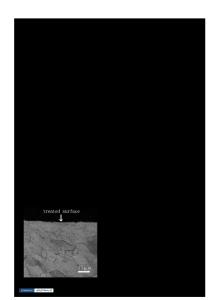Effect of oxide layer on surface energy; collective considerations
- PDF / 237,448 Bytes
- 2 Pages / 612 x 792 pts (letter) Page_size
- 112 Downloads / 341 Views
Heterogeneous
[Second-(andhigher-)order superlatticetransitions?]
/
D~'~sls~laclve
Reconstructive Diffusion
Interfacialreactmn
Diffusmnplusinterfacialreaction
Cellular
Precipitation
The O r g a n i z a t i o n of A m e r i c a n States supported the v i s i t i n g p r o f e s s o r s h i p u n d e r which this r e s e a r c h was done at the I n s t i t u t o de P e s q u i s a s R a d i o a t i v a s , D i v i sion of M a t e r i a l s S c i e n c e , Belo H o r i z o n t e , B r a s i l . 1. G Petzowand H. L. Lukas:Z. Metallk., 1970,vol.61, pp. 877-84. 2. J. W.Chnstian:The Theory of Transformations in Metals and Alloys, Pergamon Press,NewYork, 1965. 3. W.D. Kingery:Introduction to Ceramics, JohnWileyand Sons,NewYork, 1960. 4. E. A. Guggenhelm:Thermodynamics, 5th ed., p. 6, North-HollandPublishing Company,Amsterdam,1967. 5. F. N. Rhines:Phase Diagrams in Metallurgy, p. 5, McGraw-Hill,NewYork, 1956. 6. J. W.Gibbs:Collected Works, vol. 1, p. 219, YaleUniversityPress,New Haven, Conn., 1957. 7. C. S Barrettand T. B. Massalski:Structure ofMetals, 3rd ed., p. 305,McGrawHill,NewYork, 1966. 8. D. S. Lieberman.TheMechanism of Phase Transformations in Crystalline Solids, pp. 167-75,Instituteof Metals,London,1969.
Effect of Oxide Layer on Surface Energy; Collective Considerations R. A. CRAIG ~T is becoming evident that a study of the collective modes provides a simple first-order picture of several metallic properties of interest to metallurgists. On the one hand, it has been demonstrated that the conventional Van der Waals interactions between two plane surfaces may be derived by considering the modification of the surface collective excitations (surface plasmons) due to the proximity of the surR. A. CRAIG is Staff Member, Battelle Memorial Institute, Columbus, Ohio. Manuscript submitted January 13, 1972. 2536-VOLUME 3, SEPTEMBER 1972
faces. ~'z These forces are, of course, relevant to the question of adhesion between media. In a recent work, the author has shown that a good description of the surface energy of simple metals m a y be obtained by a consideration of the surface collective modes. 3 The surface energy is of considerable interest to the metallurgist because it enters into the G r i f f i t h c r i t e r i o n for f r a c t u r e which b a l a n c e s the e n e r g y of new s u r f a c e p r o d u c e d a g a i n s t the e l a s t i c e n e r g y r e l e a s e d upon the growth of an i n t r i n s i c crack. 4 An i n t e r e s t i n g p o s s i b l e c o n c l u s i o n f r o m the p o i n t of view of e n v i r o n m e n t a l l y a s s i s t e d f r a c t u r e c o m e s if we apply the theory of Ref. 3 to i n t e r f a c e s b e t w e e n two d i f f e r e n t m a t e r i a l s . It is known f r o m e x p e r i m e n t that e x t r a n e o u s m a t e r i a l on the s u r f a c e l o w e r s the s u r f a c e e n e r g y (for i n s t a n c e pump oil on m e r c u r y 5 or an oxide l a y e r on a l u m i n u m~ have both b e e n obs e r v e d to lower the s u r f a c e e n e r g y ) w h e r e a s m
Data Loading...








